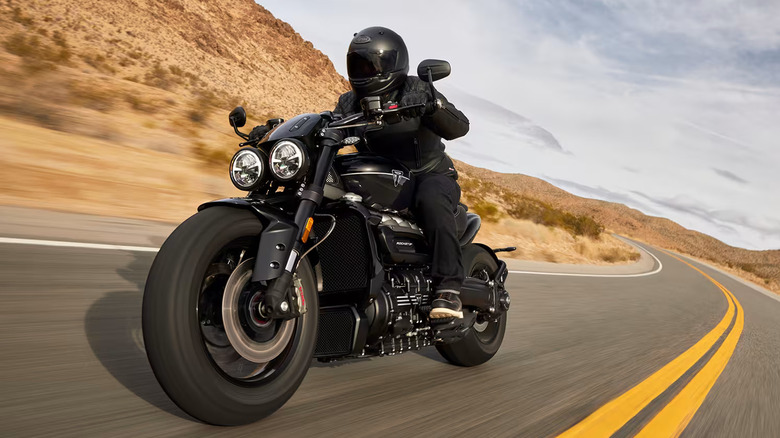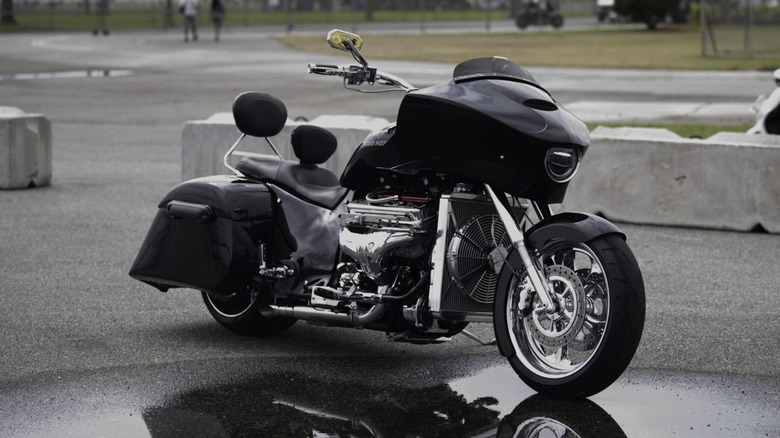What's The Highest CC Street Legal Motorcycle You Can Buy?
The best motorcycles for new riders are small, lightweight, and manageable. They often hover around 300cc of engine displacement, and power is pretty low. On the other side of the spectrum, though, there are some massive bikes. Forget your 600cc or 1000cc supersport bikes. Even big 1,200cc cruisers or dual-sport bikes seem small by comparison when you start looking at some of the largest bikes on the market. Packed with features, sometimes tipping the scales at nearly 1,000 pounds, and embodying the phrase "there's no replacement for displacement," these bikes are best left to experienced riders. But just how big can a motorcycle get and still be road-legal?
Motorcycles like the ultra-cruiser Honda Gold Wing are a massive step up even from large liter bikes, with its six-cylinder, 1,833cc engine. But there are bikes, often V-Twins or parallel twins, that go even further. The Indian Chieftain and Challenger PowerPlus bikes have 1,835cc engines, while the Harley-Davidson Road Glide uses the Milwaukee-Eight 117 engine, which comes in at 1,917cc.
But those all fall short of the Triumph Rocket 3 and its massive 2,458cc engine. For some context, the Rocket's engine has almost 25% more displacement than the four-cylinder engine in the Honda Accord Hybrid — and the Triumph is missing a cylinder, too. There's nothing from major motorcycle manufacturers that can compete.
What does all that displacement do in the Rocket 3?
Triumph currently sells two versions of the Rocket 3: the Storm R and the Storm GT. Both use the liquid-cooled, inline-3 engine with a 110.2mm bore and 85.9mm stroke, displacing 2,458cc. The engine generates an impressive 180 hp and 166 lb-ft of torque. That said, the Rocket 3's top speed isn't exactly stunning; Triumph says it will do 138 mph, and many 600cc sport bikes will easily top that.
The significant weight is a big part of what slows down the Rocket 3. Triumph claims it measures 317 kg wet, which equates to nearly 700 pounds without a rider. As a naked bike with no fairings, the Rocket isn't very aerodynamic, either. It's pretty unlikely that Rocket 3 riders are expecting supersport levels of pace, but it's a reminder that engine size doesn't always translate to outright speed. The price of the Rocket 3 is reflective of the rarefied air it breathes, with the Storm R starting at $38,890 and the Storm GT bumping that up to $39,890 (both prices including destination). Limited Evel Knievel editions of the Rocket 3 start even higher, at $45,900.
Non-standard bikes and honorable mentions
The Rocket 3's engine topped our list of the 10 biggest motorcycle engines ever made, but there are some other large engines worth mentioning. The 2,343cc Harley-Davidson crate engines, Kawasaki's 2,053cc Vulcan V-Twin, and Indian's Thunderstroke 116 come close, but they all pale compared to Boss Hoss Cycles and their V8-powered machines.
With mostly custom builds, Boss Hoss isn't your typical motorcycle manufacturer. They source V8s from manufacturers like GM that can range from 6.2 to 7.5 liters. The engines put out unreal horsepower numbers when you put them in a motorcycle, with some Boss Hoss builds going well beyond the 500-hp mark. If you're looking for big power from a big engine, it doesn't get much better than a car V8 stuffed into a motorcycle frame. If you're looking for something more traditional, though, the Triumph Rocket 3 is as big as they come.


